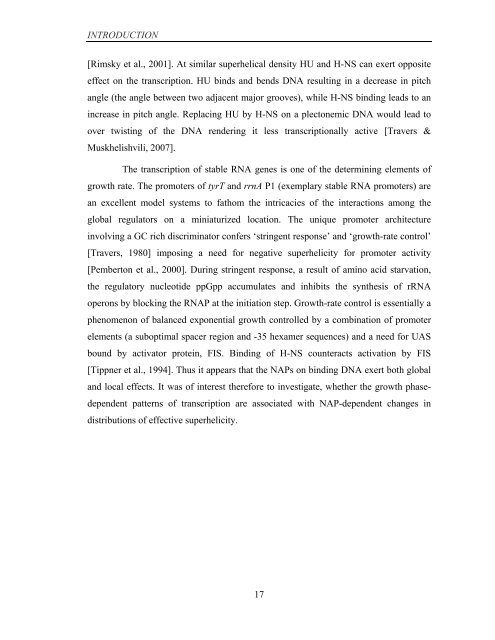Coordinated regulation of gene expression by E ... - Jacobs University
Coordinated regulation of gene expression by E ... - Jacobs University
Coordinated regulation of gene expression by E ... - Jacobs University
You also want an ePaper? Increase the reach of your titles
YUMPU automatically turns print PDFs into web optimized ePapers that Google loves.
INTRODUCTION<br />
[Rimsky et al., 2001]. At similar superhelical density HU and H-NS can exert opposite<br />
effect on the transcription. HU binds and bends DNA resulting in a decrease in pitch<br />
angle (the angle between two adjacent major grooves), while H-NS binding leads to an<br />
increase in pitch angle. Replacing HU <strong>by</strong> H-NS on a plectonemic DNA would lead to<br />
over twisting <strong>of</strong> the DNA rendering it less transcriptionally active [Travers &<br />
Muskhelishvili, 2007].<br />
The transcription <strong>of</strong> stable RNA <strong>gene</strong>s is one <strong>of</strong> the determining elements <strong>of</strong><br />
growth rate. The promoters <strong>of</strong> tyrT and rrnA P1 (exemplary stable RNA promoters) are<br />
an excellent model systems to fathom the intricacies <strong>of</strong> the interactions among the<br />
global regulators on a miniaturized location. The unique promoter architecture<br />
involving a GC rich discriminator confers ‘stringent response’ and ‘growth-rate control’<br />
[Travers, 1980] imposing a need for negative superhelicity for promoter activity<br />
[Pemberton et al., 2000]. During stringent response, a result <strong>of</strong> amino acid starvation,<br />
the regulatory nucleotide ppGpp accumulates and inhibits the synthesis <strong>of</strong> rRNA<br />
operons <strong>by</strong> blocking the RNAP at the initiation step. Growth-rate control is essentially a<br />
phenomenon <strong>of</strong> balanced exponential growth controlled <strong>by</strong> a combination <strong>of</strong> promoter<br />
elements (a suboptimal spacer region and -35 hexamer sequences) and a need for UAS<br />
bound <strong>by</strong> activator protein, FIS. Binding <strong>of</strong> H-NS counteracts activation <strong>by</strong> FIS<br />
[Tippner et al., 1994]. Thus it appears that the NAPs on binding DNA exert both global<br />
and local effects. It was <strong>of</strong> interest therefore to investigate, whether the growth phasedependent<br />
patterns <strong>of</strong> transcription are associated with NAP-dependent changes in<br />
distributions <strong>of</strong> effective superhelicity.<br />
17
















